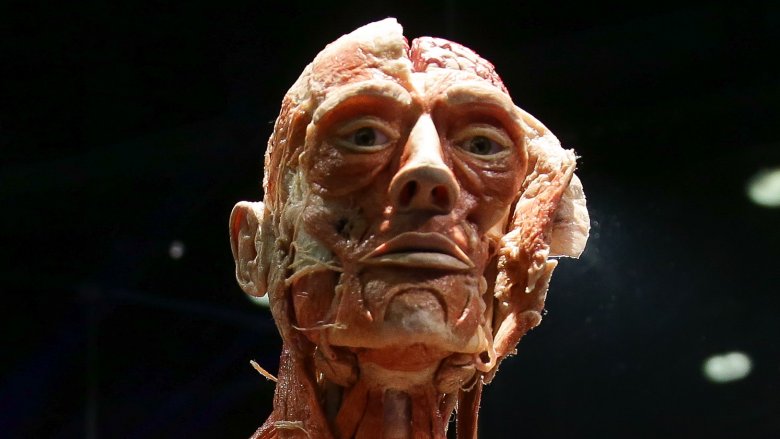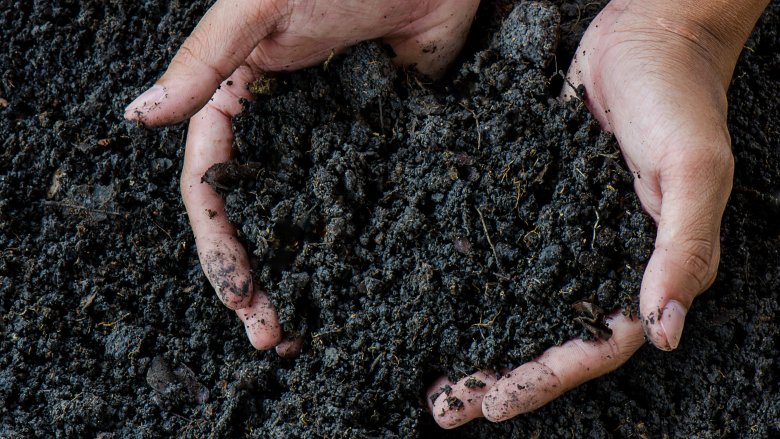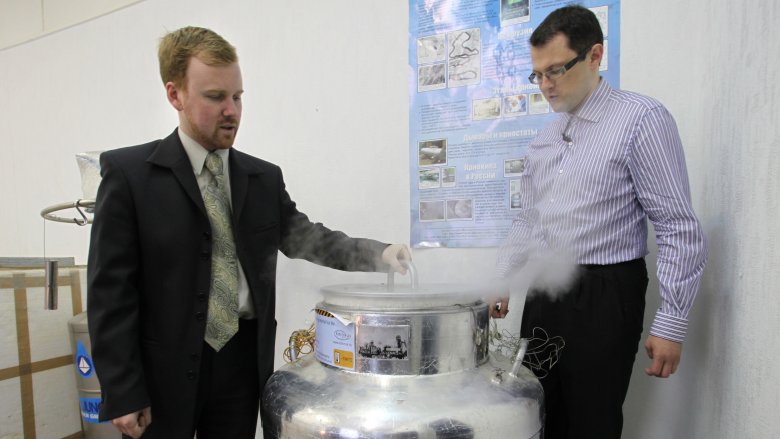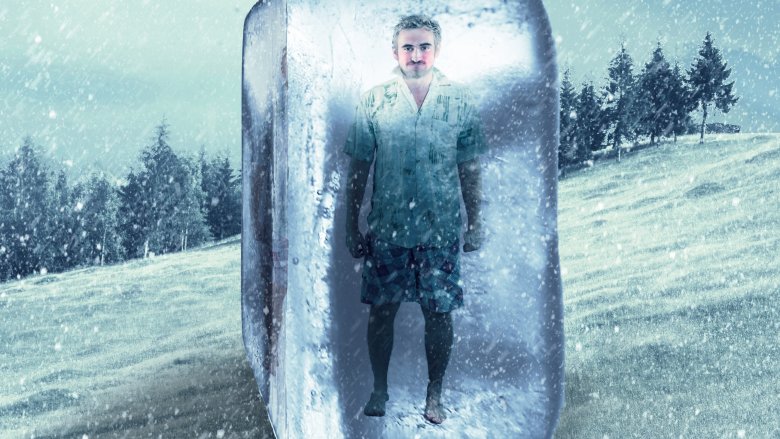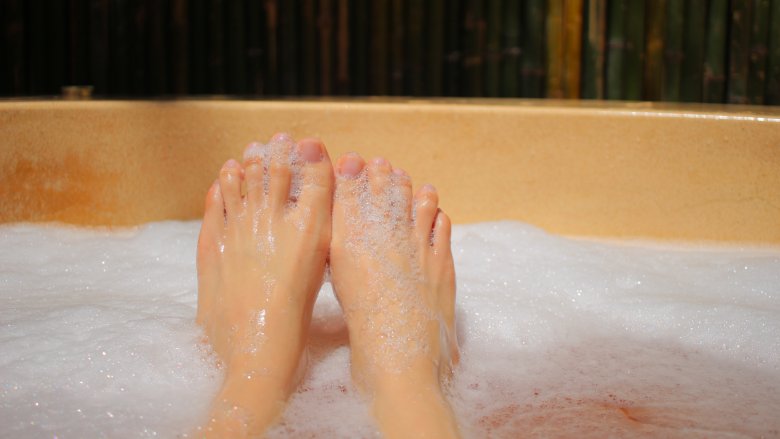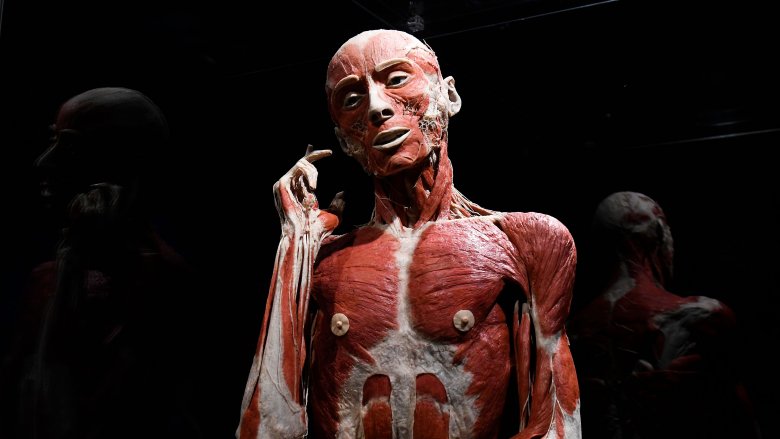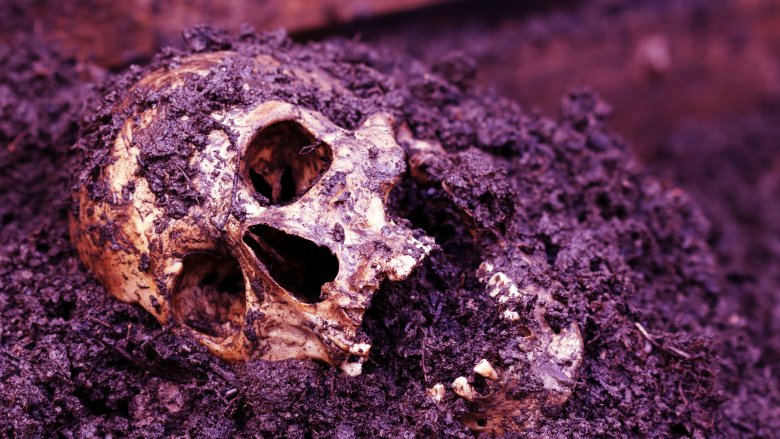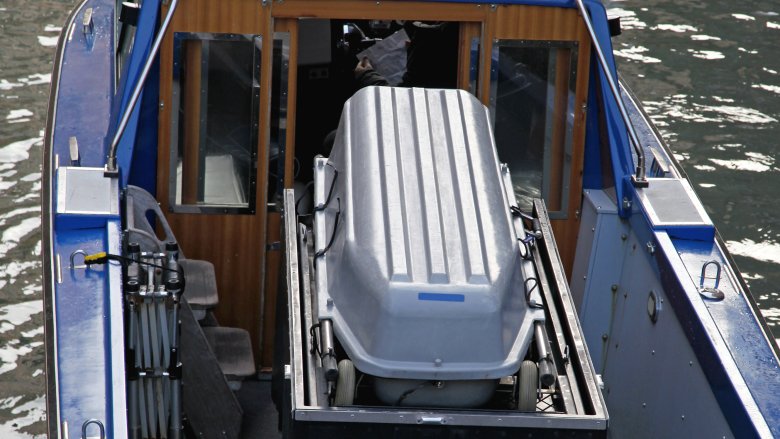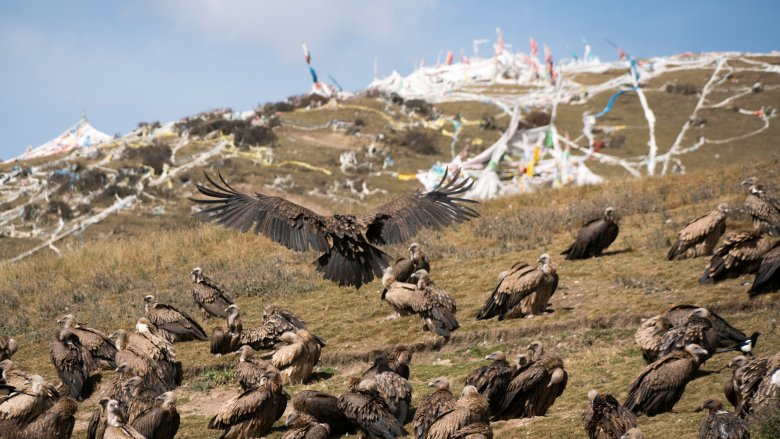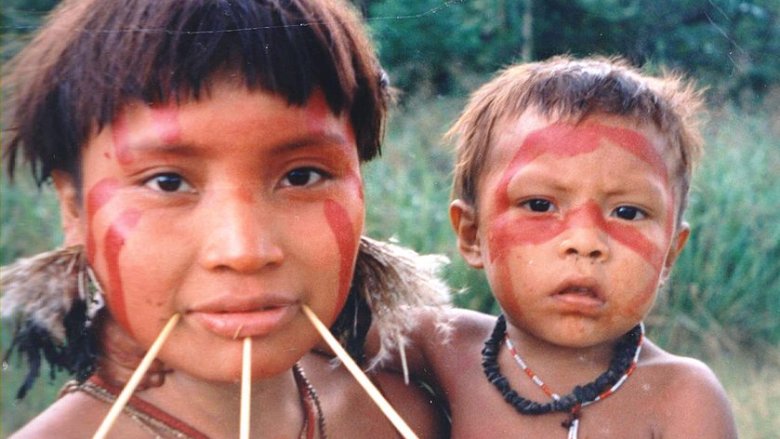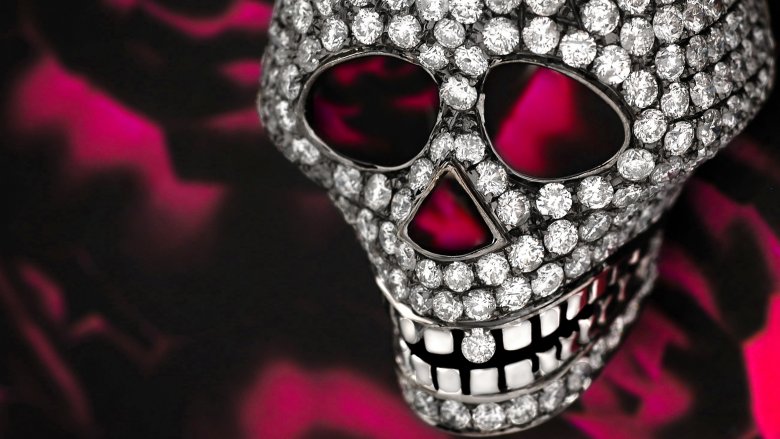What Really Happens To Bodies That Aren't Buried
Everyone is going to die, like it or not, so it's worth thinking about what will happen to your remains when you do. For most of human history, the answer was simple: burial. Putting dead bodies far underground kept them away from the people lucky enough to still be alive.
But burial is on the way out. Embalming is unbelievably bad for the environment (it's also a really disgusting process.) In 2016, cremation became the most popular way of disposing of remains in the US for the first time. But burning a body takes a lot of energy and produces a lot of carbon dioxide. It's not much better as an eco-friendly death option. So people are looking elsewhere, and they're getting extremely creative.
By the time most millennials and younger die, the options for what to do with their remains will be endless. They will be much greener. And some of them will be (and already are) kind of gross. So let's take a look at the corpses that don't end up beneath the dirt. From green options to sparky solutions, here's what really happens to bodies that aren't buried.
Corpse composting is better than being buried
Washington made headlines in 2019 for becoming the first state to legalize "natural organic reduction," which is a polite way of saying corpse composting. Also known as "human composting," "body composting," or "recomposition," the process involves taking a dead person and turning them into soil. It's like a compost heap for kitchen scraps, except those scraps had hopes and dreams and left behind a family who loved them.
If you decide on this new option (and live somewhere it's allowed), after you die, your body will be taken to a specially designed facility that's "part public park, part funeral home, part memorial," according to Smithsonian.com. There, your body is put in a container with wood chips, alfalfa, and straw. Then the microbes get to work on your lovely, decaying flesh.
About seven weeks later, your remains have been converted to about a cubic yard of nutrient-rich compost. This can be returned to the family, like cremation remains (only browner), or used by conservation groups to nourish soil. For a generation who grew up on Mufasa telling Simba how the circle of life required their dead bodies to feed the grass, it's a beautiful option. After all, it's hard to give back to the soil when you're filled with chemicals in a lead-lined coffin.
It's eco-friendly in other ways, as well, using one-eighth the energy of cremation and saving a metric ton of carbon dioxide for every body composted. One EPA employee claimed it's the most "environmentally sound" funeral option there is.
Cryonics is a cool alternative to a traditional burial
In the 1960s, technology caught up to science fiction. The ability to preserve bodies after death became so advanced, theoretically, people could be reanimated in the future. The field of cryonics was born on January 12, 1967, when a professor of psychology who'd just died of liver cancer was the first body to be cryopreserved. No, Walt Disney's body wasn't frozen after he died. Baseball player Ted Williams's corpse was, however, after a controversial legal decision. (Claims his remains were abused were denied by the cryonics company.) And today, it's a pretty cool option for the recently deceased.
Cryonics has seriously advanced in the past half century. If you choose it, after you die, NBC News reports that your blood will be replaced with "mixtures of antifreeze compounds and organ preservatives," which is basically the same way eggs are frozen in fertility treatments. While your body is preserved in liquid nitrogen, the real goal is to keep your memories intact. Even cryonic proponents admit reviving a body like Lazarus probably isn't possible. Instead, it's hoped the brain will remain intact enough to download a person's personality and memories into robots in the future. It's claimed this should be possible within 50 to 100 years.
Not everyone agrees, however. As Michael Hendricks of McGill University in Montreal, Canada, put it, "Reanimation or simulation is an abjectly false hope that is beyond the promise of technology and is certainly impossible with the frozen, dead tissue offered by the 'cryonics' industry." Still, the hope of life after death is so great, as of 2017, 250 bodies were in a deep freeze.
Promession shakes your body to bits
Biologist Susanne Wiigh-Mäsak was really into gardening, but she realized how bad all the embalmed dead people were for her precious soil. So, like one does, she spent 20 years perfecting a greener way to dispose of bodies. Her solution? Well, it's promession. Atlas Obscura calls it something an "ecologically minded supervillain" would invent.
Promession first involves removing the body from the coffin, because it's assumed there would be remains for a viewing, wake, or whatever you might want as a final goodbye. The corpse is placed in the "Promator" machine and cryogenically frozen in liquid nitrogen. So far, sounds similar to cryonics, but then it takes a sharp left turn. The freezing process in promession isn't meant to preserve but to make it easier to destroy. Once the corpse is a frozen popsicle, the Promator goes to work, shaking the body until it breaks down into teeny, tiny chunks about a millimeter in length. The whole thing takes a few minutes. Then the pile of remains is freeze dried, removing any liquid that's left over. Metal bits like fillings are removed. Then the dusty pile of what was once a human is put in a biodegradable container. It's buried in a shallow grave so the topsoil will break down the urn and get nutrients from the remains.
Promession isn't legal anywhere yet, although Sweden considered it. Some people doubt the process is even possible. But companies are still working on promession, and if they crack it, it'll be an eco-friendly option.
Resomation lets you have one last bath
Cremation's popularity is on the rise, and the only thing that could slow it down is the fact it's so bad for the environment. Logically, this means funeral directors looking to get some of those green dollars want a way you can destroy a body without destroying the Earth.
A process like that exists, and it's known alternately as "water cremation," "resomation," or "aquamation" (or "alkaline hydrolysis" if you want to get really technical about your funeral options). You take a dead body you have lying around, and pop it in a high-pressure chamber that looks kind of like an MRI machine. The chamber is filled with a mixture of water and lye, then heated to 200-300 degrees. Up to 12 hours later, everything but bones is a brown liquid, which is simply flushed away, reports The New Republic. The bones are ground up, and the remains are returned to the family who can save them, inter them, or spread them just like with a more fire-based cremation.
It sounds high-tech, but this process was patented in 1888. For a long time, it was used to quickly and cheaply dispose of animal carcasses. Then vets got in on it as a way to cremate beloved pets. This got people interested in using it themselves or for loved ones. In 2003, Minnesota became the first state to legalize resomation. As of 2019, it's an option in 15 states, and places like the Mayo Clinic use it regularly.
Plastination is posable, creepy fun
If you like the idea of donating your body to science but wish there was a way your remains could also become art, plastination is the answer to a question you didn't even know you needed answered. If you've ever seen the wildly popular and seriously creepy Body Worlds exhibits (pictured) that travel the globe, that's what your insides could have in store for them if you wanted.
Inventor Gunther von Hagens explained in The Guardian how, as a research scientist in the 1970s, he studied specimens embedded in plastic and questioned "why the plastic was poured around bodies rather than into them." He spent years experimenting with a new technique, patenting it in 1978, and 13 years later, he managed to plastinate a whole body. Bustle reports it's a complicated process that involves "replacing the water and fat contained in tissues with a reactive polymer such as silicone rubber, epoxy, or polyester resins," and it takes 1,500 working hours (about a year) to complete. As of 2018, plastinated bodies or body parts were used in 400 medical institutions.
The idea here was originally to improve teaching methods. But regular people were interested too, and Body Worlds first went on display in Japan (home of the weird) in 1995. The plastic-filled bodies have become art. But like art, they're sometimes sold. If you donate your body for plastination, you have no control what happens to you after that. Still, 17,000 people have signed up to be plastinated, including the inventor himself.
Body farms are perfect for those obsessed with true crime
Crime scenes involving dead bodies are always complicated. But if the corpse is outside, this adds a whole host of extra difficulties for investigators. It's one thing to theoretically know how bodies will react in the great outdoors, it's another to test it. So according to their website, that's what the FBI started doing in 1981. The first person donated their remains that year, and the Body Farm was born.
You can still donate your body to the farm (technically, the Anthropology Research Facility in Knoxville and six other locations) today and help contribute to forensic research. Just know what you're signing up for. Remains don't get treated nicely, because murderers don't care about funerary rituals. Instead, as the website explains, "donors are left to decompose in various states — partially clothed, wrapped in plastic, placed in a car trunk, or in a garbage bin." Some are submerged in water. Then experts and students take notes, which helps them in real-life crime scene scenarios. As odd as it seems, forensic scientists say people are constantly asking to donate.
If you're not in the States but love CSI and want to get in on this, you might be able to. The Body Farm idea is spreading, with Nature reporting that some have opened in the Netherlands and Australia, with ones planned for the United Kingdom and Canada. They will probably become even more common. One UK expert pushed for their farm because she said forensic teams were falling behind on research compared to countries that had them.
Whole body donation isn't as scary as it sounds
In 2019, the media gleefully reported on a body-donation company in Arizona that turned out to be a Frankenstein laboratory of freakery. According to CBS News, family members of those who'd donated their bodies expected their loved ones to be used to further scientific research and help save lives. Instead, a 2014 FBI raid on Biological Resource Center discovered the owner was making thousands of dollars by selling dead bodies for all kinds of things, including to the military for use in blast tests (meaning, a guy found out his beloved mother's body was exploded by the Army). The FBI also found a "cooler filled with male genitalia" and "a small woman's head sewn onto a large male torso" hanging on a wall.
Obviously, this is sick and twisted in the extreme. But it shouldn't put people off whole body donation. See, whole body donation is a completely separate thing to organ donation, and it's very important for medical research. The process has lots of myths swirling around it. You can donate even if you were sick when you died, and you can donate if you have tattoos, piercings, or a pacemaker, and there are no hidden costs.
And if you find a legitimate place to donate your body to, there are no worries about the Army blowing you up without your permission. For example, the Mayo Clinic has a whole body donation program, and it doesn't seem like the kind of place to keep a bucket of genitals lying around.
Burial at sea is an option for everyone
Burial at sea is a time-honored tradition for fishermen, sailors, and members of the aquatic branches of the military. In recent years, the most famous sea burials are probably the unlikely duo of Neil Armstrong and Osama bin Laden. Legally, anyone who wants to can commit their mortal remains to the deep. There are tons of rules and regulations, though, so don't just go dumping grandma in a tide pool.
According to Mother Jones, in the US, you must tell the Environmental Protection Agency what you're planning a month before, and you need to dump the body at least three miles offshore in deep water (the exact depth depends on where you are.) The BBC reports the UK has even stricter rules. There are only three acceptable burial locations. Plus, you need to pay for a license and get a doctor's note saying the body isn't diseased.
Burial at sea isn't common, but it may be getting more popular. There aren't numbers on how many people choose it, but in 2011, an EPA official said she'd gone from getting one or two calls a year inquiring about it to at least one call a week.
The US Navy offers full-body sea burials for veterans, but the corpse must be embalmed and sealed in a metal casket. This ruins the green effect a lot of people who choose ocean burial are looking for. One New England company goes a more historically accurate way by putting the body in a canvas bag and attaching a cannonball.
Sky burials aren't meant to be tourist traps
Tibetan Buddhists dispose of bodies in a way that can seem gruesome to outsiders. One man and his family stumbled on a sky burial, and he reported on it for the Australian Broadcasting Corporation. What they saw was 100 vultures sitting on a hill expectantly. Nuns were chanting. And there was a body bag.
A Buddhist monk acting as the rogyapas ("body breaker") appeared and took a butcher knife to the corpse. The guy watching said it was so gross he almost puked. When the monk was finished, the vultures "swarmed, in a frenzy jumping on top of each other tearing at the flesh ... like some ancient biblical scene."
Within 15 minutes, nothing was left but the bones, which was great. After all, it's considered a bad omen if the vultures leave anything behind. The rogyapas smashed up the bones with a hammer, mixed them with butter and flour, and fed that to the vultures as well. The birds are considered angels who take the deceased's soul to heaven to wait for reincarnation.
It might seem weird that some random Australians witnessed something so personal. But they aren't the only ones. Sky burials have become a draw for tourists. Inverse says China tried passing laws stopping foreigners from gawking at this emotional ritual, but they still come in droves anyway. Some have even been caught on video, laughing as a monk asked them to leave. These guys even went so far as to demand their money back after not being able to get a good view. Now that's really gross.
Endocannibalism might make a gastronomic comeback
Cannibalism is seen as the stuff of horror movies, tragedies like the Donner Party, and psychos like Jeffrey Dahmer. But cannibalism was practiced in many places around the world for a lot of history. Some of it was exocannibalism, meaning eating people from outside the tribe, like your enemies. But just as common was endocannibalism, which means eating people from your own tribe, especially relatives who died.
This might seem disgusting, but The Independent reports it was an "expression of respect for the lost loved ones." According to The New Republic, endocannibalism was one of the most important funerary rituals for the Wari' tribe in the Amazon. Consuming the dead was a sign the deceased had passed on and released their spirit. Unlike when they ate enemies happily and with gusto, eating the corpse of a tribe member wasn't supposed to be nice. By the time the funeral took place, the corpse was already putrefying. Those selected to eat some of the deceased did not enjoy it.
The Fore people of Papua New Guinea ate the body and brain of their tribal dead. This caused a major problem. At some point, a deadly molecule in the brain of one of the corpses passed on to the people who consumed it and spread exponentially from there. While endocannibalism was mostly outlawed in the 1950s and '60s, in 2014, Stanford professor Paul Ehrlich said overpopulation would drive humans to eating each other on a much larger scale. As food becomes scarce, consuming our dead might become an important source of protein.
Cremation options can be creative
While cremation is barely better for the environment than embalming, it's so hot right now, in more ways than one. And it's not going away anytime soon. The National Funeral Directors Association estimates that by 2035, 80 percent of dead people in America will be cremated. But just because you selected the same method of disposal as everyone else, that doesn't mean you have to be boring. Cremation offers a ton of fun ways to spend eternity, instead of sitting in a regular old urn.
Say you want to be cremated, but you feel guilty about the carbon footprint. The solution might be putting your ashes in a biodegradable pod that then feeds a tree, according to CNN. (The inventors hope to eventually be able to skip the cremation part altogether and put whole bodies in the pods.)
Humans are basically just carbon, and conveniently, so are diamonds. So if you loved jewelry in life, you can become it in death. National Geographic reports numerous companies will compress your ashes until they turn into a diamond. Then your loved ones can wear you and pass you down for generations. Or if you'd rather just be hung on a wall, ABC News says one artist will mix your ashes with paint and create an artwork for your family to enjoy.
And there's so much more you can do. You can be shot into space, added to a coral reef, 3D printed, made into bullets ... the options are endless. In other words, your body doesn't have to be buried, and there are plenty of ways to make death fun.
